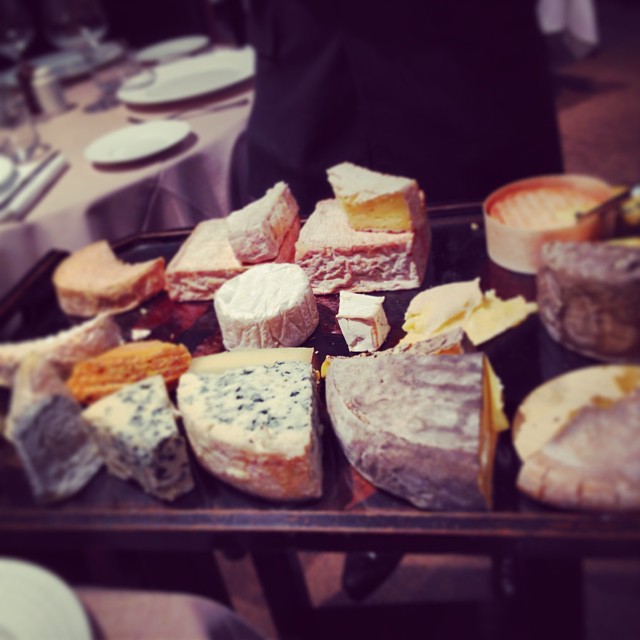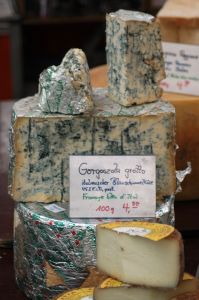Cheeses of Italy
While in Rome last week I had a cheese course after dinner nearly every night. Like in France (where I had the cheese course after dinner the week before) the waiter brought out beautiful trays of cheeses. Some of the cheeses were mild and some were rather stinky, but all were delicious. Here is a bit about some of the various cheeses of Italy.
Asiago: Named for the plateau at the foot of the Dolomites to the north of Vicenza in the Vento region, is a pale cow’s milk cheese with a slightly sweet taste; aged and hardened it can be grated. It is made in several versions, from a hard, half-fat cheese to a soft, full-fat version.
Britto: From the Sondrio province of Lombardia (the Valtellina) is made of cow’s milk and ten percent goat’s milk.
Caciocavallo: Comes from Southern Italy, where it is stretched and shaped by hand, like mozzarella and provolone. Made with cow’s milk, caciocavallo when it is young has a firm, smooth texture and a mildly salty flavor that grows more pungent as it is aged. It is often made into a gourd shape, and smoked versions are available.
Fior di Latte: Is a soft, fresh cheese from cow’s milk, which literally means, “flower of milk.”
Fontina: Is an unpasteurized cow’s milk cheese, the most authentic and delicious examples of which come from the slopes of the Valle d’Aosta. With its delicate, buttery, nutty flavor, fontina is a favorite for cooking, as it melts beautifully.
Gorgonzola: Is Italy’s most famous blue cheese. It was born in Lombardia, but almost all of it today is produced in Piemonte. Made of cow’s milk, most Gorgonzolas are aged from three to six months. The mildest, sweetest versions (aged for the minimum) are called Gorgonzola dolce; the most pungent, Gorgonzola picante.
Grana: Is a general term for a hard, grainy-textured cheese often used for grating. The original recipes here often called simply for grana, the expectation being that one would use the grana of that recipe’s region. Since these local grana cheeses are not widely available outside Italy.
Montasio: Is a firm cow’s milk cheese similar to Asiago, available aged or fresh. It comes from Friuli-Venezia Giulia.
Mozzarella: Is one of the most famous and widely available cheeses in Italy, though southern versions are considered the best. Mozzarella di bufala is made from buffalo milk rather than cow’s milk, as is most common today. Buffalo milk is creamier than cow’s and imparts a more velvety texture and tangier fragrance.
Parmigiano-Reggiano: Is a hard cheese made from partly skimmed cow’s milk by a centuries-old method in the provinces of Parma, Reggio Emilia, Modena, and Bologna in Emilia-Romagna and Mantova in Lombardia.
Pecorino: Refers to any Italian sheep’s milk cheese (pecora is Italian for “sheep”); of the dozens of varieties of pecorino cheeses, the most famous version is pecorino Romano, which has a sharp and pungent flavor that makes it mainly appropriate for cooking or for grating like Parmigiano-Reggiano. Pecorino dolce is a young and fresh pecorino with a notable sweetness and softer texture.
Provolone: Is a sharp and tangy, firm-textured cow’s milk cheese that originated in the Basilicata region of southern Italy; like gorgonzola, it has lighter-flavored versions referred to as dolce, and stronger-flavored, aged versions referred to as picante. Both versions can also be smoked and are good for cooking.
Ricotta: In Italian means, “Re-cooked,” and refers to a soft, milk creamy-white cheese traditionally made from the whey remaining after making pecorino. Today, most ricotta is made from cow’s milk. It has a very mild, lightly tart flavor and slightly grainy texture. It is also often used in desserts and baking. Ricotta salata refers to ricotta to which salt has been added as a preservative, making it less moist and a preservative, making it less moist and more pungent in flavor than fresh ricotta. Robiola is a goat’s milk cheese that often contains cow’s and sheep’s milk. It has a creamy texture and is not aged beyond three weeks.
Scamorza: From Abruzzo and Molise, is a pasta filate (“pulled or spun dough”) cheese that is shaped by hand, like provolone or mozzarella. A cow’s milk cheese with a mild, creamy flavor similar to mozzarella, it is sometimes smoked.
Taleggio: Is made in the Taleggio Valley north of Bergamo as well as in other centers in Lombardia and in Treviso in the Veneto. Made in square forms, it is a semisoft cow’s milk cheese with a delicate creamy taste but a pungent aroma.
Toma: Toma is also known as tuma and can mean different kinds of cheeses. The first is a smooth, firm, cow’s milk cheese from Lombardia and Piemonte, traditionally aged between three and eighteen months. In Sicilia, toma refers to fresh ewe’s milk curds molded in a basket. In the north, tuma refers to an unsalted goat’s milk cheese.







